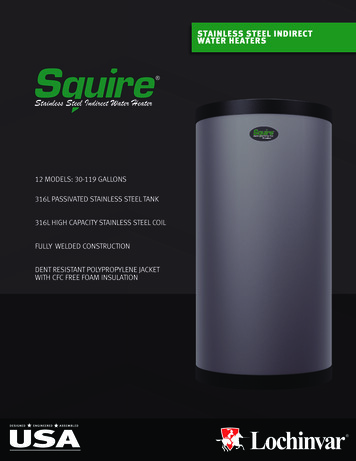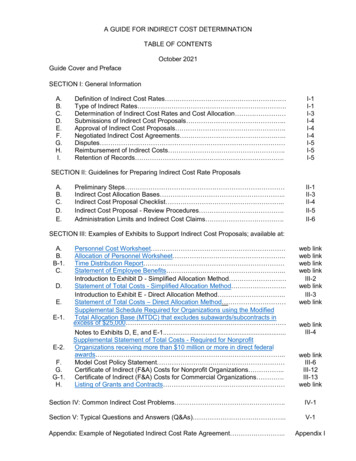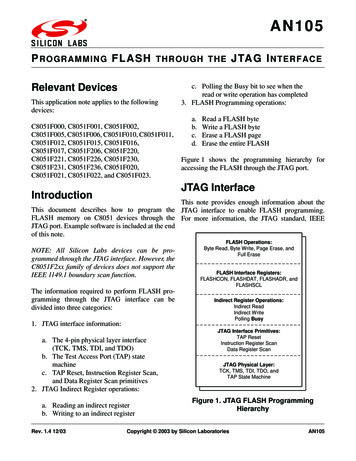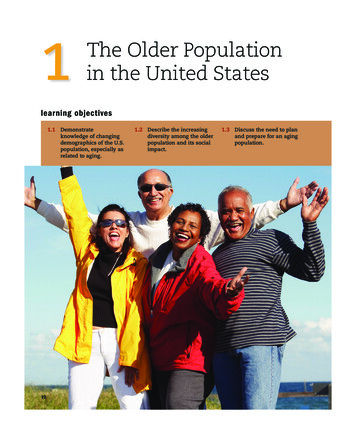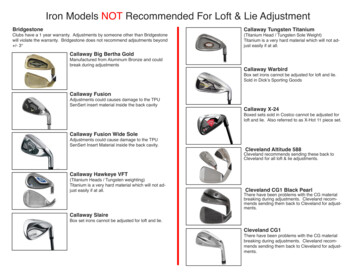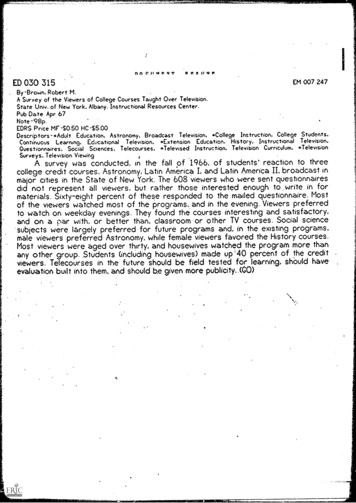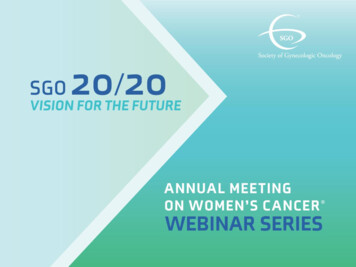
Transcription
Population-adjusted indirect comparison of the SOLO1and PAOLA-1/ENGOT-ov25 studies of olaparib with orwithout bevacizumab, bevacizumab alone and placebo inthe maintenance treatment of women with newlydiagnosed stage III/IV ovarian cancer with BRCA mutationIgnace Vergote,1 Kathleen Moore,2 Robert Hettle,3 Kirsty Rhodes,3Mario Ouwens,4 Isabelle Ray-Coquard5University Hospital Leuven, Leuven Cancer Institute, Leuven and BGOG, Belgium; 2StephensonCancer Center at the University of Oklahoma, Oklahoma City, OK, USA; 3AstraZeneca, Cambridge,UK; 4AstraZeneca, Gothenberg, Sweden; 5Centre Léon Bérard, Lyon and GINECO, France1The SOLO1 study was sponsored by AstraZenecaClinicalTrials.gov identifier: NCT01844986The PAOLA-1 study was sponsored by ARCAGY ResearchClinicalTrials.gov identifier: NCT02477644
DisclosuresIgnace Vergote: Consulting and advisory fees from Advaxis, Amgen, AstraZeneca, Clovis Oncology, CarrickTherapeutics, Debiopharm International, Eisai, F Hoffmann-La Roche, Genmab, GSK GlaxoSmithKlinePharmaceuticals, Immunogen, Medical University of Vienna, Millennium Pharmaceuticals, MSD, OctimetOncology, Oncoinvent, Pharmamar-Doctaforum Servicios, Roche, Sotio, Tesaro and Tesaro Bio. Contractedresearch from Oncoinvent and Genmab. Corporate sponsored research from Amgen and Roche. Travelexpenses from Amgen, MSD/Merck, Tesaro, AstraZeneca and RocheKathleen Moore: Advisory board participation for AstraZeneca, Aravive, Clovis, Eisai, Genentech/Roche,Immunogen, Merck, Tesaro, Tarveda and Vigeo. Research funding from Lilly, PTC Therapeutics, Merck andGenentech/RocheRobert Hettle: Employee of AstraZeneca PLC and shareholderKirsty Rhodes: Employee of AstraZeneca PLCMario Ouwens: Employee of AstraZeneca PLCIsabelle Ray-Coquard: Consulting fees and travel support from Roche and AstraZeneca. Consulting fees fromPharmaMar, Genmab, Pfizer, Tesaro and Clovis. Grant support and consulting fees from MSD
Introduction There is a need to understand the role of bevacizumab in themaintenance treatment of patients with newly diagnosed BRCA-mutatedovarian cancer (GOG218)1 With data from the Phase III SOLO12 and PAOLA-13 trials of olaparibmaintenance in patients with newly diagnosed advanced ovarian cancer,a population-adjusted indirect treatment comparison was conductedto assess the comparative efficacy of:‒‒‒‒Bevacizumab monotherapy versus placeboOlaparib monotherapy versus bevacizumab monotherapyOlaparib plus bevacizumab versus olaparib monotherapyOlaparib plus bevacizumab versus placebo1. Norquist BM et al. Clin Cancer Res 2018;24:777–83; 2. Moore K et al. N Engl J Med 2018;379:2495–505; 3. Ray-Coquard I et al. N Engl J Med 2019;381:2416–28
PAOLA-1 and SOLO1 trial designsPAOLA-1SOLO1 Newly diagnosed FIGO stage III–IV HGSOC orHGEOC (or peritoneal)* and in clinical completeresponse or partial response after platinum-basedchemotherapy including bevacizumab† ECOG performance status 0–1 Surgery (upfront or interval) tBRCAm or non-tBRCAm statusStratificationStratification tBRCAm status‡ First-line treatment outcome§2:1randomizationOlaparib (300 mg bid)plus bevacizumab†N 537 Newly diagnosed, FIGO stage III–IV HGSOC orHGEOC (or peritoneal)* and in clinical completeresponse or partial response after platinumbased chemotherapy ECOG performance status 0–1 Surgery (upfront or interval) Germline or somatic BRCAmMaintenance therapyPlacebo plusbevacizumab†N 269 Response to first-lineplatinum chemotherapy2:1randomizationOlaparib (300 mg bid)N 260PlaceboN 131*Patients with other epithelial non-mucinous ovarian cancers were eligible if they had a germline BRCAm; †Bevacizumab: 15 mg/kg every 3 weeks for a total of 15 months, including when administered with chemotherapy;‡By central laboratories; §According to timing of surgery and NED/CR/PRbid, twice daily; BRCAm, BRCA1 and/or BRCA2 mutation; CR, complete response; ECOG, Eastern Cooperative Oncology Group; FIGO, Federation of Gynecology and Obstetrics; HGEOC, high-grade endometrioid ovariancancer; HGSOC, high-grade serous ovarian cancer; NED, no evidence of disease; PR, partial response; tBRCAm, tumor BRCA1 and/or BRCA2 mutation
Methods An unanchored, population-adjusted indirect comparison was performed for the endpoint ofinvestigator-assessed PFS (RECIST v1.1).1 This comparison used individual patient data fromthe SOLO1 trial and from the subset of patients with a tBRCAm in PAOLA-1 A propensity score weighting technique was used to minimize differences in observablecharacteristics between the trial populations– The weights assigned to individuals in PAOLA-1 were related to the probability of being inthe olaparib arm of SOLO1*– Matching variables identified for adjustment were tumor location, ECOG status, histologictype, FIGO stage, type of surgery, residual disease, response to first-line treatment, andage Weighted Cox regression and Kaplan–Meier analyses were performed to estimate thecomparative efficacy of different treatment strategiesAll analyses were performed in patients with complete baseline data. Although this indirect treatment analysis is based on accepted methodology, it was not possible to address all differences in baseline characteristics asthe analysis was non-randomized. *The olaparib arm of SOLO1 was selected as the target population as it represents the current standard of care for patients with newly diagnosed advanced ovarian cancer and a BRCAm1. Phillippo DM et al. NICE DSU Technical Support Document 18: Methods for population-adjusted indirect comparisons in submissions to NICE. 2018PFS, progression-free survival; RECIST, Response Evaluation Criteria in Solid Tumors
MethodsSOLO1Propensity weightingPatients were reweighted to achieve balance in key baseline characteristicsOlaparibPlaceboPAOLA-1 patients who were SOLO1-like received greater weight than those whowere not SOLO1-likePAOLA-1 BRCA subsetOlaparib plusbevacizumabSOLO1-like patientsPlacebo plusbevacizumabPAOLA-1 BRCA reweight*Olaparib plusbevacizumabPlacebo plusbevacizumabNon-SOLO1-like patientsThe olaparib arm of SOLO1 was selected as the target population as it represents the current standard of care for patients with newly diagnosed advanced ovarian cancer and a BRCAm. All analyses were performed in patientswith complete baseline data. *Icons sized to denote weights
Key baseline characteristics (pre-adjustment)PAOLA-1 (tBRCAm subset))SOLO1Olaparib plusbevacizumabN 151Placebo plusbevacizumabN 71OverallOlaparibPlaceboOverallN 222N 254N 126N 380Tumor location (% ovary)859287858685ECOG (% status 1)252425231922FIGO (% stage IV)283129141816Surgery (% interval)*433841373436Residual disease (%)323032222322First-line outcome (% PR)151716262124Mean age (years)57.055.056.453.653.453.5Age (% 65 years)221520131514Population imbalances could potentially lead to differences in PFS outcomes between arms, irrespective of treatment assignmentThe analyses were performed on the SOLO1 data and the subset of patients in PAOLA-1 who had confirmed tBRCAm. All analyses were performed in patients with complete data on matching variables. Ten patientsfrom the original PAOLA-1 olaparib bevacizumab cohort, nine patients from the original PAOLA-1 placebo bevacizumab cohort, six patients from the original SOLO1 olaparib cohort, and five patients from the originalSOLO1 placebo cohort had missing values for matching variables; therefore, they were excluded. The implications of removing those with missing data was assessed. Although this indirect treatment analysis is basedon accepted methodology, it was not possible to address all differences in baseline characteristics as the analysis is non-randomized. In SOLO1, median follow-up was 40.7 months in the olaparib arm and 41.2 monthsin the placebo arm. In PAOLA-1, median follow-up was 22.7 months in the olaparib bevacizumab arm and 24.0 months in the placebo bevacizumab arm. *Patients who did not have surgery were excluded from thispopulation-adjusted indirect treatment comparison
Adjusted baseline characteristicsPAOLA-1 (tBRCAm subset)SOLO1Olaparib plusbevacizumab*N 151ESS 110.8Placebo plusbevacizumab*N 71ESS 54.7OlaparibPlaceboN 254N 126Tumor location (% ovary)84888586ECOG (% status 1)23292319FIGO (% stage IV)14161418Surgery (% interval)†40373734Residual disease (%)26222223First-line outcome (% PR)19172621Mean age (years)54.353.953.653.4Age (% 65 years)16131315The weighted PAOLA-1 BRCAm subset of patients had comparable baseline data to the SOLO1patients, with 14% with FIGO stage IV and 26% with residual disease after surgery, with the exception offirst-line outcomeAll analyses were performed in patients with complete data on matching variables. The analyses were performed on the SOLO1 data and the subset of patients in PAOLA-1 who had confirmed tBRCAm. A sensitivity analysiswas conducted to assess the impact of the difference in first-line outcome. This sensitivity analysis found that the different CR rates across arms had little impact on the hazard ratios estimated from the weighted Coxproportional hazards models. *Values are weight adjusted to match baseline characteristics to the olaparib arm of the SOLO1 trial; †The values for patients who did not have surgery were not weight adjustedESS, effective sample size, represents the approximate number of independent non-weighted individuals that would be required to give an estimate with the same precision as the weighted sample
PFS outcomes in the population-adjusted indirect comparison:Bevacizumab monotherapy versus placeboPatients free from diseaseprogression and death (%)100Kaplan–Meier estimate of patients progression-freePAOLA-1tBRCAm subsetSOLO1Placebo plusbevacizumab*N 71Placebo12 months815324 months50367550%5036%25N 126HR 0.65 (95% CI 0.43–0.95)†00612182430364248Time since randomization (months)In SOLO1, median follow-up was 40.7 months in the olaparib arm and 41.2 months in the placebo arm. In PAOLA-1, median follow-up was 22.7 months in the olaparib bevacizumab arm and 24.0months in the placebo bevacizumab arm. *These results are based on weighted outcomes after matching tumor location status, ECOG status, FIGO stage, type of surgery (interval vs upfront), residualdisease status after surgery, response to first-line treatment, and age to SOLO1; †CIs generated by bootstrappingCI, confidence interval; HR, hazard ratio
PFS outcomes in the population-adjusted indirect comparison:Olaparib monotherapy versus bevacizumab monotherapyPatients free from diseaseprogression and death (%)100Kaplan–Meier estimate of patients progression-freeSOLO1PAOLA-1tBRCAm subsetOlaparibN 254Placebo plusbevacizumab*N 7112 months888124 months735073%7550%5025HR 0.48 (95% CI 0.30–0.75)†00612182430364248Time since randomization (months)In SOLO1, median follow-up was 40.7 months in the olaparib arm and 41.2 months in the placebo arm. In PAOLA-1, median follow-up was 22.7 months in the olaparib bevacizumab arm and 24.0months in the placebo bevacizumab arm. *These results are based on weighted outcomes after matching tumor location status, ECOG status, FIGO stage, type of surgery (interval vs upfront), residualdisease status after surgery, response to first-line treatment, and age to SOLO1; †CIs generated by bootstrapping
PFS outcomes in the population-adjusted indirect comparison:Olaparib plus bevacizumab versus olaparib monotherapy100Kaplan–Meier estimate of patients progression freePatients free from diseaseprogression and death (%)82%PAOLA-1tBRCAm subsetSOLO1Olaparib plusbevacizumab*N 151Olaparib12 months968824 months82737573%5025N 254HR 0.71 (95% CI 0.45–1.09)†00612182430364248Time since randomization (months)In SOLO1, median follow-up was 40.7 months in the olaparib arm and 41.2 months in the placebo arm. In PAOLA-1, median follow-up was 22.7 months in the olaparib bevacizumab arm and 24.0months in the placebo bevacizumab arm. *These results are based on weighted outcomes after matching tumor location status, ECOG status, FIGO stage, type of surgery (interval vs upfront), residualdisease status after surgery, response to first-line treatment, and age to SOLO1; †CIs generated by bootstrapping
PFS outcomes in the population-adjusted indirect comparison:Olaparib plus bevacizumab versus placebo100Kaplan–Meier estimate of patients progression-freePatients free from diseaseprogression and death (%)82%PAOLA-1tBRCAm subsetSOLO1Olaparib plusbevacizumab*N 151Placebo12 months965324 months8236755036%25N 126HR 0.23 (95% CI 0.14–0.34)†00612182430364248Time since randomization (months)In SOLO1, median follow-up was 40.7 months in the olaparib arm and 41.2 months in the placebo arm. In PAOLA-1, median follow-up was 22.7 months in the olaparib bevacizumab arm and 24.0months in the placebo bevacizumab arm. *These results are based on weighted outcomes after matching tumor location status, ECOG status, FIGO stage, type of surgery (interval vs upfront), residualdisease status after surgery, response to first-line treatment, and age to SOLO1; †CIs generated by bootstrapping
Conclusions The PAOLA-1 trial showed that patients with newly diagnosed BRCAmutated ovarian cancer had a PFS benefit with combination olaparib plusbevacizumab maintenance therapy versus bevacizumab alone1 An unprecedented PFS benefit to patients with a BRCAm receivingmaintenance monotherapy was observed with olaparib in the SOLO1trial2 This population-adjusted indirect treatment comparison suggests thatolaparib plus bevacizumab leads to an improvement in PFS versusolaparib alone as maintenance for patients with BRCA-mutated newlydiagnosed advanced ovarian cancerMedian follow-up was different for the SOLO1 and PAOLA-1 trials1. Ray-Coquard I et al. N Engl J Med 2019;381:2416–28; 2. Moore K et al. N Engl J Med 2018;379:2495–505
AcknowledgmentsFundingARCAGY Research,AstraZeneca, Merck & Co, Incand Hoffmann-La Roche LtdMedical writing supportLaura Smart, MChem, funded byAstraZeneca and Merck & Co, IncWe thank all the patients, their families, the investigators, and thestaff who participated in the SOLO1 and PAOLA-1 trials
Comparison of PFS outcomes in the adjustedand the unadjusted populationsPopulation-adjusted indirect comparisonUnadjusted population100Patients free from diseaseprogression and death (%)Patients free from diseaseprogression and death (%)1007550250061218243036Time since randomization (months)Olaparib plus bevacizumab4248Olaparib7550250061218243036Time since randomization (months)Placebo plus bevacizumabPlacebo4248
Placebo plus bevacizumab* N 71 12 months 88 81 24 months 73 50 HR 0.48 (95% CI 0.30-0.75)† 50% 73% In SOLO1, median follow-up was 40.7 months in the olaparib arm and 41.2 months in the placebo arm. In PAOLA-1, median follow-up was 22.7 months in the olaparib bevacizumab arm and 24.0 months in the placebo bevacizumab arm.
